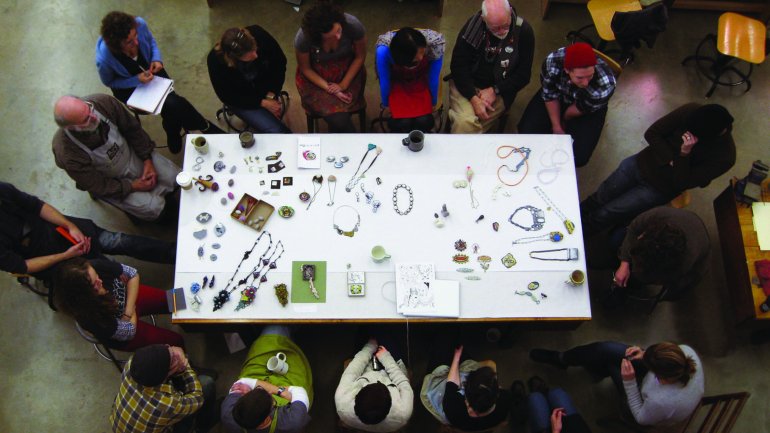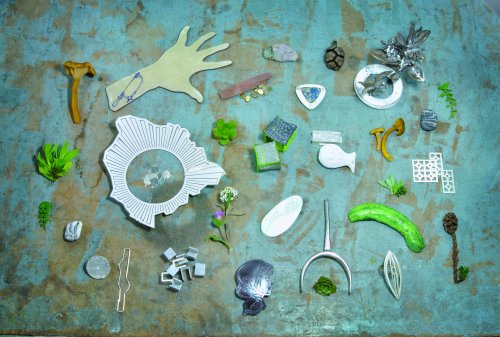Q&A: Smitten Forum Organizers Marissa Saneholtz and Sara Brown
While many people are returning sweaters and writing resolutions, Marissa Saneholtz and Sara Brown are busily prepping for the Smitten Forum, a weeklong gathering of metalsmiths. Smitten, in its sixth year, brings together between 12 and 18 artists to live, learn, and work side-by-side for a week.
This year, 14 metalsmiths, including Saneholtz and Brown, will gather at the Mendocino Art Center December 29, getting to know each other, making metal objects, and sharing meals – and laughs – through the following Sunday. This year's participants are Marissa Saneholtz, Sara Brown, Kristin Beeler, Marilyn da Silva, Jack da Silva, Abigail Heuss, Tova Lund, Dawn Nakanishi, Heather Nuber, Kris Patzlaff, Jan Smith, Kristina Smith, Rachelle Thiewes, and Myung Urso.
Every year since Smitten began at the Arrowmont School of Arts and Crafts in 2014, the week has been followed by the production of a catalogue memorializing the gathering and at least one exhibition of work produced by the participants. This year, a July exhibition at Form & Concept in Santa Fe will feature work by Smitten metalsmiths of the last six years. The show will culminate in a symposium on metalsmithing, with lectures and demonstrations and revelry.
Brown and Saneholtz teach at Winthrop University in South Carolina and Bowling Green State University in Ohio, respectively, when they’re not in their studios. We asked them to tell us how Smitten started and why it continues.
Every year beginning in 2014, you two have gathered a different group of metalsmiths to work alongside each other for a week. Why did you start doing this?
Marissa Saneholtz: A few years ago, I was assisting Bob Ebendorf at a workshop at Arrowmont and was approached by one of the resident artists there, Jason Bige Burnett. He’s a ceramist, and he had been hosting a forum for ceramists. And he encouraged me to look at renting space at Arrowmont in the off season. “You pretty much have free rein,” he said. “You can do whatever you want.” So I called up Sara Brown, who is my best friend from undergrad at Bowling Green State University. And she said she’d be happy to help.
Where does the funding come from?
Sara Brown: Everybody pays their own way. We try to not extend past $500, which doesn’t include travel.
MS: It’s just a minimal amount for housing and studio rental, and then everyone puts in some money for food and things like that. We like to keep it affordable, so we can invite a range of people – including emerging artists, people right out of school, and adjuncts. We all know adjuncts don’t have any money.
So the first year was at Arrowmont. And then?
MS: We’ve moved to a bunch of different locations, because we wanted to make sure we were able to invite people who couldn’t travel as far.
This year you’ll be at the Mendocino Art Center in California for the second time.
SB: Yes, they have invited us back, which is awesome, because we really, really, really enjoyed the last time.
What did you enjoy about it?
SB: Well, the location; it was beautiful. And the staff is wonderful, and they just let us have free rein with no distractions or any other groups around.
How do you decide who to invite?
SB: I think of it as a mix of half of what we want, half word of mouth from past participants. We don’t know everyone, and if we just were inviting the people that we knew or wanted to share the space with, that wouldn’t be exciting. It really helps to have that reference from somebody who was there, who is recommending somebody who they think would enjoy the experience or contribute to the environment.
MS: We want to have a well-rounded showing from the field. We like to invite people of a range of ages, emerging artists, as well as artists who are very well established. And then, we like to invite people who work in a variety of media. We try not to have all enamelists or all fabricators or all people who do technology. We try to pick and choose a little bit from all of them so that the experience is a little bit more diverse.
What kind of experience are you going for?
MS: We really just try to create an environment similar to graduate school – camaraderie, being able to work in studio with other people. As far as the crafts go, metalsmiths tend to be very…
SB: Solitary.
MS: Isolated, solitary – we tend to have our studios that are tiny, attached to our houses, and we don’t have a lot of community, especially if you’re not in a big city. My colleague at the university is the only metalsmith within quite a few miles of where I am. So coming together allows for us to just hang out in the studio and work and make our thing, and maybe have a conversation with somebody, or maybe focus in and get that thing done for a show that you have coming up that you’ve been putting off because you don’t want to be isolated in the studio by yourself.
SB: It’s really very casual and relaxed, because everybody’s doing their own thing but then they come together.
MS: Yes, at mealtime. We really celebrate sharing food across the table. During the event, everybody signs up in teams to make dinner for everybody else in the group.
That sounds wonderful.
MS: It’s fun. And that usually ends up being the only competitive point of the whole experience – sometimes people are like, “I’m gonna make the best dinner!” We put out a publication every year that highlights the event and the artists. We have essays, written by a few of the artists, and we put the recipes in the back of the book.
And do you show work that people produced during the event?
SB: Each person has their own little section with their bio, and then a piece that they are known for or that people would recognize as theirs. And then there’s a spread of their bench during the week, so you see their process and, hopefully, a piece moving across various stages of completion.
Who funds the catalogue?
MS: Smitten participants do.
SB: We don’t announce it, really, but usually, the second-to-last day, when everyone’s feeling nostalgic and doesn’t want to leave…
You hit them up for money.
SB: And then we have wine and…
MS: We make sure there’s a very good dinner planned that night…
SB: And then, we’re like, “So…there’s a catalogue. Who here would like to push some money our way to make this happen?”
Sounds shrewd. How much do you need for the catalogue, roughly?
MS: Usually, it’s about $2,500. And we print through Indiana University Press, anywhere from 100 to 150 catalogues, every year.
So people get together, they eat together, they work side-by-side. Besides getting together and forming community, are there any goals, or is there any outcome you’re looking for?
SB: For me, this is more about actually getting to know the people in the field, humanizing them beyond their work. You get to know their sleep schedule and what they like for breakfast.
MS: Do they take cream or sugar in their coffee?
SB: You get to know people in a really short amount of time, and it’s really great.
How would you describe the value of getting to know people in the field?
SB: We’re all a part of the community, but if you’re just existing in it and not connecting with those around you, are you really a part of that, other than you-as-your-work?
MS: It’s the building of relationships and opportunities for afterwards, too. So if we invite people who work at a university, they can an invite an artist they didn’t know before to be a visiting artist, and then their students will learn who they are; sometimes people collaborate, make work together afterward; people learn from other people. The fact that you’re able just to work next to somebody – you usually end up learning something or maybe changing the way you make one little thing, and that really impacts a lot of artists. Also, just breathing that creative life back into people’s practices.
SB: It’s important to also pull in the quiet makers – the people who are so busy teaching that they don’t really have time to put their work out there, and nobody knows what they make, because they don’t see it, or they just don’t have time.
So somehow you figure out the people who are open to this, and from that pool of people, you curate 14 or 15 people. Is that how it works?
MS: Sometimes we just send people cold invitations. They don’t have any idea who we are; maybe – they may or may not have heard of us, and we’re like, “Hey, we’re doing this thing. Would you like to come?” This will be our sixth go-through of the Smitten Forum, in 2019, and we have a little bit of a reputation, I hope. So people, when they get an invitation, they’re like, “Oh, I’ve heard of this thing before.”
Where does the name come from?
SB: This is where we have two completely different answers.
Oh, good.
SB: It’s not really two different answers, but Marissa likes to jump straight to the definition of “to hit or strike.”
MS: Or, just to be smitten with someone, like you have a crush on somebody.
SB: That’s a lot of the reason why I would put somebody’s name on a list, is because I want to know more about them, or I really enjoy their work and want to get to know them more.
Later in 2019, you’ll be putting on an exhibition at Form & Concept that will involve some 50 makers.
MS: Probably more like 70 past participants.
SB: But the symposium, the last weekend in July in Santa Fe, is larger. Anybody can come.
MS: We’re trying to figure out all the logistics of it – demonstrations and lectures and just a celebration of metalsmithing and jewelry making.
Well, this is a fascinating endeavor.
MS: Yeah, people say, “Oh, my gosh, you do so much work for this.” And we’re like, “Yeah, it’s worth it, because we get to go to every one.”
It sounds like something you both really look forward to.
SB: It’s usually the highlight of my year.



